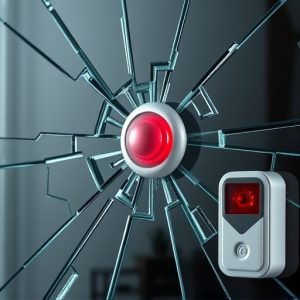Mastering Glass Break Alarm Sensors: Installation, Maintenance, and Advanced Security Tips
Glass break alarm sensors are integral to modern home security systems, designed to accurately detec…….
Glass break alarm sensors are integral to modern home security systems, designed to accurately detect the sound of breaking glass. These devices work by analyzing sound waves to distinguish between the acoustic signature of glass impact and other noises, thereby reducing false alarms. They are equipped with sensitive microphones tuned to a wide range of frequencies, allowing them to identify the unique sonic profile associated with glass fracturing. Optimal installation involves placing the sensor 4 to 6 feet above ground level and in a central location for an unobstructed view of all potential entry points. Regular testing, cleaning, and maintenance are crucial to maintain their effectiveness, ensuring they remain sensitive and accurate. Some sensors incorporate AI to adapt to environmental sounds and may include pet immune technology to avoid triggering by pets. When connected to smart home systems, these sensors can provide remote monitoring and immediate alerts to security teams or devices, enhancing protection against unauthorized access. The combination of strategic placement, consistent maintenance, and advanced features like AI and pet immunity makes glass break alarm sensors a key component in securing homes and businesses.
When it comes to safeguarding your home or business, a glass break alarm sensor stands as a silent sentinel, its advanced technology designed to detect the sound of breaking glass and alert you to potential intrusions. This article delves into the inner workings of these devices, offering insights on their installation, maintenance, and the best practices for maximizing their protection capabilities. Whether you’re new to security systems or looking to enhance your existing setup, understanding how a glass break alarm sensor operates is key to leveraging its full potential. Join us as we explore the science behind this innovative security technology and ensure your premises remain secure.
Understanding Glass Break Detector Sensors: The Science Behind Glass Break Alarm Technology
Glass break detector sensors represent a sophisticated component within the realm of home security systems, designed to detect the acoustic signature of glass being broken. These sensors operate on the principle of sound-wave analysis, distinguishing between the pattern of sounds produced by the impact and breakage of glass versus other noises. Upon activation, which can be triggered by a predetermined level of decibels indicative of breaking glass, these systems swiftly send an alarm signal to alert homeowners or security monitoring services.
The technology behind glass break alarm sensors involves advanced algorithms capable of differentiating between the specific frequencies and patterns associated with glass fracturing. These algorithms are trained using a database of sound samples that represent both the noise of glass breaking and non-alarm sounds, thereby minimizing false alarms. The sensors are often equipped with microphones that are sensitive to a broad spectrum of audio frequencies, allowing them to accurately identify the unique sonic profile of broken glass. This capability not only enhances security measures but also ensures a swift response to potential intrusions, providing an additional layer of protection for homes and businesses alike.
Installing and Maintaining Your Glass Break Alarm Sensor for Optimal Security
When it comes to installing a glass break alarm sensor, precision and placement are paramount for effective security. Begin by selecting a central location within your residence or commercial space that allows the sensor to monitor all potential points of entry where glass could be compromised. Adhere to the manufacturer’s instructions, ensuring that the sensor is positioned at a height that offers an unobstructed view of windows and doors. A common best practice is to install the sensor 4 to 6 feet above the ground, avoiding direct sunlight or other environmental factors that might interfere with its sensitivity. Proper mounting also involves securing the sensor to a solid structure, such as metal or concrete, to prevent movement that could affect its functionality.
Once installed, regular maintenance is crucial for maintaining the integrity of your glass break alarm sensor’s performance. Regularly test the sensor by simulating a window break within a controlled environment to ensure it responds accurately. Clean the sensor according to the manufacturer’s guidelines to remove dust, cobwebs, or any other residue that could interfere with its acoustic sensors. It’s also wise to check the battery or power supply regularly to avoid unexpected failures. By following these installation and maintenance procedures, your glass break alarm sensor will serve as a reliable deterrent against intruders and enhance the overall security of your property.
Glass Break Alarm Sensor Efficiency: Best Practices and Advanced Features for Enhanced Protection
Glass break alarm sensors are integral components of modern security systems, providing immediate alert to potential intrusions by detecting the acoustic signature of glass being broken. To maximize their efficiency, it is essential to install these sensors strategically, placing them at vantage points where they can capture the sound of glass fracture without interference from ambient noise. The optimal positioning often involves a combination of elevated placement and distance from potential sound sources. Additionally, regular maintenance and testing are crucial to ensure the sensor’s responsiveness and sensitivity are calibrated correctly to distinguish between breakage sounds and other auditory phenomena.
Advanced features in glass break alarm sensors enhance protection by incorporating artificial intelligence algorithms capable of learning and adapting to typical sound patterns in a given environment, reducing false alarms. Some models offer pet immune technology, minimizing the likelihood of pets triggering the alarm. Furthermore, integration with smart home systems allows for remote monitoring and instant notifications to security personnel or connected devices. By leveraging these advanced features and following best practices for placement and maintenance, glass break alarm sensors can provide a robust layer of defense against unauthorized entry.


